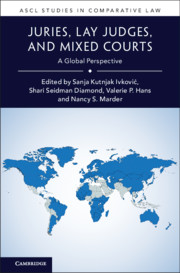Book contents
- ASCL Studies In Comparative Law
- Juries, Lay Judges, and Mixed Courts
- Copyright page
- Contents
- Editors
- Contributors
- Acknowledgments
- 1 Introduction
- Part I Advances in Lay Participation
- 2 The Rise of the Jury in Argentina
- 3 Twelve Years of Mixed Tribunals in Argentina
- 4 Lay Participation in the Criminal Trial in Japan
- 5 The Korean Jury System
- 6 The Twenty-Fifth Anniversary of the Spanish Jury
- Part II Enduring Systems of Lay Participation
- Part III Challenges to Lay Participation in Law
- Part IV Global Perspectives on Lay Participation
- Name Index
- Subject Index
- References
6 - The Twenty-Fifth Anniversary of the Spanish Jury
from Part I - Advances in Lay Participation
Published online by Cambridge University Press: 03 August 2021
- ASCL Studies In Comparative Law
- Juries, Lay Judges, and Mixed Courts
- Copyright page
- Contents
- Editors
- Contributors
- Acknowledgments
- 1 Introduction
- Part I Advances in Lay Participation
- 2 The Rise of the Jury in Argentina
- 3 Twelve Years of Mixed Tribunals in Argentina
- 4 Lay Participation in the Criminal Trial in Japan
- 5 The Korean Jury System
- 6 The Twenty-Fifth Anniversary of the Spanish Jury
- Part II Enduring Systems of Lay Participation
- Part III Challenges to Lay Participation in Law
- Part IV Global Perspectives on Lay Participation
- Name Index
- Subject Index
- References
Summary
A quarter-century has elapsed since the introduction of the Jury Law (Ley del Jurado) in Spain in 1995. This chapter describes trial by jury and its functioning over this period and also considers its chances for survival in the future. The chapter begins with the main features of the Spanish jury and includes changes to the Spanish judicial system after the introduction of jurors. This chapter also provides an overview of the current state of jury trials in Spain, including new statistics and judicial practices. Controversial and high-profile jury trials illustrate some of the strengths and weaknesses of the jury’s performance in Spain over the past 25 years.
Keywords
- Type
- Chapter
- Information
- Juries, Lay Judges, and Mixed CourtsA Global Perspective, pp. 107 - 128Publisher: Cambridge University PressPrint publication year: 2021

